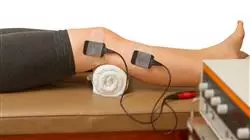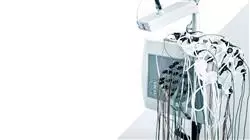University certificate
The world's largest faculty of medicine”
Introduction to the Program
Treat ailments such as fibromyalgia or chronic pain with the latest neurophysiological techniques, becoming the best practitioner in your area"

The management of pathologies such as drug-resistant chronic pain, epilepsy, fibromyalgia or even depression can benefit from the appropriate use of neurophysiological therapies. Throughout this course, the student will learn about the latest advances in this field and how to apply the different types of neuromodulation techniques to different ailments.
Thus, students will gain extensive knowledge of neurophysiological therapies, a speciality that will undoubtedly be of great use in their medical career, as it will allow them to treat various common pathologies more effectively.
An awareness of the continuous advances made in neurophysiological therapies will also provide the student with significant scope for growth within their area of healthcare.
All this in a completely online Postgraduate certificate, where the student can download the entire syllabus from the first day of teaching. This, together with the absence of classes and fixed schedules, makes it possible for the student to decide when to assume the entire study load, without abandoning their current work or personal commitments.
You are choosing the best academic institution, with professional and personalized support that you won't find in other programs"
This Postgraduate certificate in Neurophysiological Techniques for Therapeutic Purposes. Invasive and Non-Invasive Neuromodulation. Botulinum Toxin contains the most complete and up-to-date scientific program on the market. Its most notable features are:
- Practical case studies presented by experts in Neurophysiology
- Graphic, schematic, and practical contents which provide scientific and practical information on the disciplines that are essential for professional practice
- Practical exercises where self-assessment can be undertaken to improve learning
- A special emphasis on innovative methodologies
- Theoretical lessons, questions to the expert, debate forums on controversial topics, and individual reflection assignments
- Content that is accessible from any fixed or portable device with an Internet connection
Don't waste your time and money on other titles that don’t take you into consideration. At TECH you make all the important decisions, without sacrificing any aspect of your personal and work life"
The program’s teaching staff includes professionals from the sector who pour their professional experience into this program, as well as renowned specialists from leading societies and prestigious universities.
The multimedia content, developed with the latest educational technology, will provide the professional with situated and contextual learning, i.e., a simulated environment that will provide immersive learning designed for real situations.
This program is designed around Problem-Based Learning, whereby the professional must try to resolve the different professional practice situations that arise during the academic year. For this purpose, the student will be assisted by an innovative interactive video system created by renowned and experienced experts.
Neuromodulation will reveal all its secrets, as you learn how to use it effectively for each pathology"

Enroll today on this Postgraduate certificate and boost your career prospects by gaining a reputation for excellent patient care"
Why study at TECH?
TECH is the world’s largest online university. With an impressive catalog of more than 14,000 university programs available in 11 languages, it is positioned as a leader in employability, with a 99% job placement rate. In addition, it relies on an enormous faculty of more than 6,000 professors of the highest international renown.

Study at the world's largest online university and guarantee your professional success. The future starts at TECH”
The world’s best online university according to FORBES
The prestigious Forbes magazine, specialized in business and finance, has highlighted TECH as “the world's best online university” This is what they have recently stated in an article in their digital edition in which they echo the success story of this institution, “thanks to the academic offer it provides, the selection of its teaching staff, and an innovative learning method aimed at educating the professionals of the future”
A revolutionary study method, a cutting-edge faculty and a practical focus: the key to TECH's success.
The most complete study plans on the university scene
TECH offers the most complete study plans on the university scene, with syllabuses that cover fundamental concepts and, at the same time, the main scientific advances in their specific scientific areas. In addition, these programs are continuously being updated to guarantee students the academic vanguard and the most in-demand professional skills. In this way, the university's qualifications provide its graduates with a significant advantage to propel their careers to success.
TECH offers the most comprehensive and intensive study plans on the current university scene.
A world-class teaching staff
TECH's teaching staff is made up of more than 6,000 professors with the highest international recognition. Professors, researchers and top executives of multinational companies, including Isaiah Covington, performance coach of the Boston Celtics; Magda Romanska, principal investigator at Harvard MetaLAB; Ignacio Wistumba, chairman of the department of translational molecular pathology at MD Anderson Cancer Center; and D.W. Pine, creative director of TIME magazine, among others.
Internationally renowned experts, specialized in different branches of Health, Technology, Communication and Business, form part of the TECH faculty.
A unique learning method
TECH is the first university to use Relearning in all its programs. It is the best online learning methodology, accredited with international teaching quality certifications, provided by prestigious educational agencies. In addition, this disruptive educational model is complemented with the “Case Method”, thereby setting up a unique online teaching strategy. Innovative teaching resources are also implemented, including detailed videos, infographics and interactive summaries.
TECH combines Relearning and the Case Method in all its university programs to guarantee excellent theoretical and practical learning, studying whenever and wherever you want.
The world's largest online university
TECH is the world’s largest online university. We are the largest educational institution, with the best and widest online educational catalog, one hundred percent online and covering the vast majority of areas of knowledge. We offer a large selection of our own degrees and accredited online undergraduate and postgraduate degrees. In total, more than 14,000 university degrees, in eleven different languages, make us the largest educational largest in the world.
TECH has the world's most extensive catalog of academic and official programs, available in more than 11 languages.
Google Premier Partner
The American technology giant has awarded TECH the Google Google Premier Partner badge. This award, which is only available to 3% of the world's companies, highlights the efficient, flexible and tailored experience that this university provides to students. The recognition as a Google Premier Partner not only accredits the maximum rigor, performance and investment in TECH's digital infrastructures, but also places this university as one of the world's leading technology companies.
Google has positioned TECH in the top 3% of the world's most important technology companies by awarding it its Google Premier Partner badge.
The official online university of the NBA
TECH is the official online university of the NBA. Thanks to our agreement with the biggest league in basketball, we offer our students exclusive university programs, as well as a wide variety of educational resources focused on the business of the league and other areas of the sports industry. Each program is made up of a uniquely designed syllabus and features exceptional guest hosts: professionals with a distinguished sports background who will offer their expertise on the most relevant topics.
TECH has been selected by the NBA, the world's top basketball league, as its official online university.
The top-rated university by its students
Students have positioned TECH as the world's top-rated university on the main review websites, with a highest rating of 4.9 out of 5, obtained from more than 1,000 reviews. These results consolidate TECH as the benchmark university institution at an international level, reflecting the excellence and positive impact of its educational model.” reflecting the excellence and positive impact of its educational model.”
TECH is the world’s top-rated university by its students.
Leaders in employability
TECH has managed to become the leading university in employability. 99% of its students obtain jobs in the academic field they have studied, within one year of completing any of the university's programs. A similar number achieve immediate career enhancement. All this thanks to a study methodology that bases its effectiveness on the acquisition of practical skills, which are absolutely necessary for professional development.
99% of TECH graduates find a job within a year of completing their studies.
Postgraduate Certificate in Neurophysiological Techniques for Therapeutic Purposes. Invasive and non-invasive neuromodulation. Botulinum Toxin
Neurophysiological techniques refer to a wide variety of assessment and therapeutic tools used to study and treat disorders of the nervous system. Some of these techniques are applied for therapeutic purposes and can be divided into invasive and noninvasive neuromodulation, as well as botulinum toxin application.
Invasive neuromodulation includes the application of deep brain stimulation, intracranial electrode implantation, percutaneous radiofrequency and other similar techniques involving the introduction of devices into the patient's body. These techniques are used in the treatment of neurological disorders such as Parkinson's disease, dystonia and epilepsy, among others.
Deep brain stimulation (DBS) consists of the implantation of an electrical stimulation device inside the brain, which is used to treat disorders such as Parkinson's disease, dystonia, epilepsy, among others. DBS is effective due to its ability to modulate activity in certain regions of the brain, which helps to reduce the symptoms of neurological disorders.
On the other hand, noninvasive neuromodulation includes techniques such as transcranial magnetic stimulation, transcranial electrical stimulation and cognitive behavioral therapy, among others. These techniques do not involve the insertion of any type of device into the patient's body.
Transcranial magnetic stimulation (TMS) uses magnetic fields to stimulate certain areas of the brain to help treat disorders such as treatment-resistant depression, Alzheimer's disease and chronic pain. TMS is a non-invasive technique that produces therapeutic results without any surgery or grafting.
Botulinum toxin application involves injecting small amounts of a neurotoxin into the muscles to relax them and reduce muscle activity in certain areas of the body. This technique is commonly used to treat neuromuscular disorders such as blepharospasm, cervical dystonia and spasticity. It can be applied both invasively and non-invasively, depending on the area of the body to be treated.
In summary, neurophysiological techniques for therapeutic purposes are a set of tools used to evaluate and treat disorders of the nervous system. These techniques can be invasive or non-invasive, and may include the application of deep brain stimulation, transcranial magnetic stimulation, botulinum toxin application, among others. Their main objective is to help treat neurological disorders and improve the quality of life of patients suffering from them.







